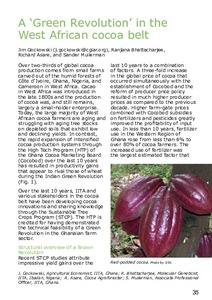| dc.contributor.author | Bhattacharjee, R. |
| dc.contributor.author | Gockowski, J. |
| dc.contributor.author | Asare, R. |
| dc.contributor.author | Muilerman, S. |
| dc.date.accessioned | 2019-12-04T11:07:46Z |
| dc.date.available | 2019-12-04T11:07:46Z |
| dc.date.issued | 2012-03 |
| dc.identifier.citation | Bhattacharjee, R., Gockowski, J., Asare, R. & Muilerman, S. (2012). A green revolution in the West African cocoa belt. 35-39. |
| dc.identifier.issn | 2071-3681 |
| dc.identifier.uri | https://hdl.handle.net/20.500.12478/1576 |
| dc.description.abstract | STCP tools for the rehabilitation of West African cocoa farms
Cacao tree stocks in West Africa are mainly established from seeds procured
from farmers’ fields. This planting material lacks the disease tolerance and
yield potential of the hybrid seed. Productivity is also affected by the old age
of West Africa’s tree stock. Replacing and rehabilitating the tree stocks of
West Africa is fundamental to the achievement and long-run sustainability of
a cocoa Brown Revolution.
The STCP has developed a Planting, Replanting and Diversification (PRD)
training package to provide farmers the knowledge and technical skills
needed to rehabilitate old cocoa farms or reclaim degraded areas using
hybrids. However, a major constraint to hybrid adoption is a lack of access
to hybrid seeds. To overcome this constraint, STCP introduced a Seed
Brokerage System (SBS) for the collective acquisition of hybrid seeds by
farmer field school groups from government production units. An initial
evaluation of 375 randomly selected trainees revealed that the mean
participant had successfully established 0.4 ha of hybrid cocoa seedling with
an 81% seedling survival rate after two dry seasons. Approximately half of
the surveyed trainees had replanted old farms while half had established
new farms on degraded fallow land. The SBS also brokered timber seedlings
for farmers desiring to include high-value timber (Terminalia ivorensis
and T. superb) as permanent shade in their production system. The mean
participant reported the successful establishment of 12 timber seedlings
which is equivalent to 30 trees per hectare. Farmers favored the SBS
innovation and are seeking its continuance. |
| dc.language.iso | en |
| dc.subject | Cocoa (Plant) |
| dc.subject | Smallholders |
| dc.subject | Fertilizers |
| dc.subject | Plant Diseases |
| dc.subject | Pests Of Plants |
| dc.title | A Green Revolution in the West African cocoa belt |
| dc.type | Journal Article |
| dc.description.version | Peer Review |
| cg.contributor.crp | Forests, Trees and Agroforestry |
| cg.contributor.affiliation | International Institute of Tropical Agriculture |
| cg.coverage.region | Africa |
| cg.coverage.region | West Africa |
| cg.coverage.country | Ghana |
| cg.coverage.country | Nigeria |
| cg.authorship.types | CGIAR single centre |
| cg.iitasubject | Cocoa |
| cg.iitasubject | Plant Diseases |
| cg.iitasubject | Pests Of Plants |
| cg.iitasubject | Smallholder Farmers |
| cg.journal | Sustainable Tree Crops Program |
| cg.howpublished | Formally Published |
| cg.accessibilitystatus | Open Access |
| local.dspaceid | 82137 |

